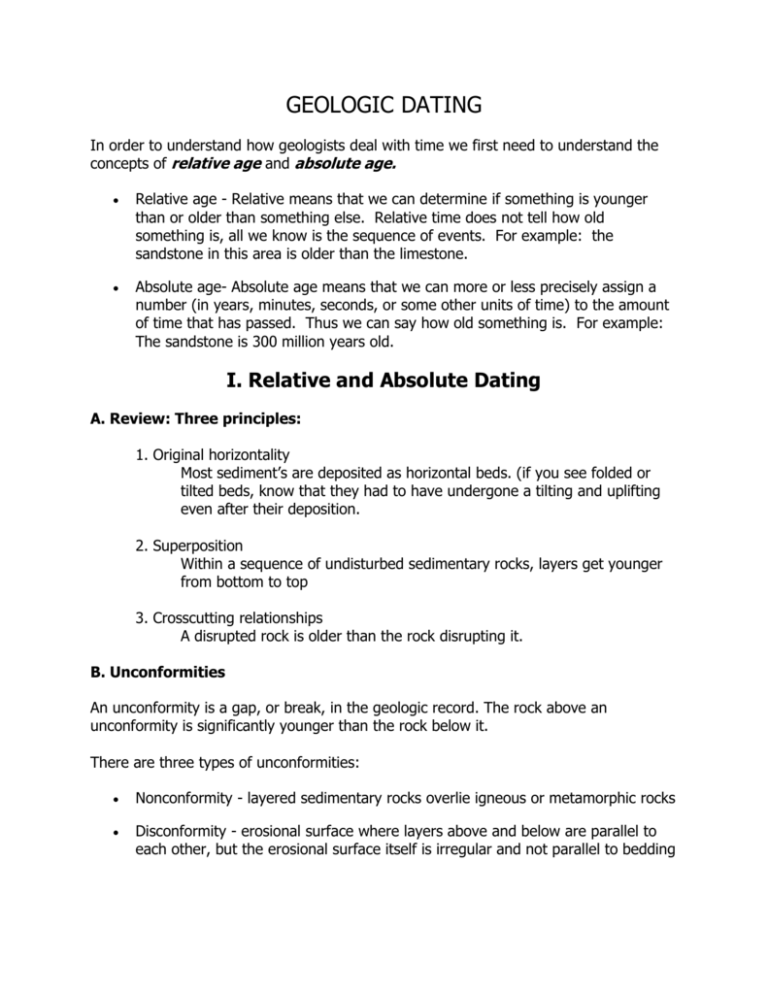Geologic Time: Dating - Notes
advertisement

GEOLOGIC DATING In order to understand how geologists deal with time we first need to understand the concepts of relative age and absolute age. Relative age - Relative means that we can determine if something is younger than or older than something else. Relative time does not tell how old something is, all we know is the sequence of events. For example: the sandstone in this area is older than the limestone. Absolute age- Absolute age means that we can more or less precisely assign a number (in years, minutes, seconds, or some other units of time) to the amount of time that has passed. Thus we can say how old something is. For example: The sandstone is 300 million years old. I. Relative and Absolute Dating A. Review: Three principles: 1. Original horizontality Most sediment’s are deposited as horizontal beds. (if you see folded or tilted beds, know that they had to have undergone a tilting and uplifting even after their deposition. 2. Superposition Within a sequence of undisturbed sedimentary rocks, layers get younger from bottom to top 3. Crosscutting relationships A disrupted rock is older than the rock disrupting it. B. Unconformities An unconformity is a gap, or break, in the geologic record. The rock above an unconformity is significantly younger than the rock below it. There are three types of unconformities: Nonconformity - layered sedimentary rocks overlie igneous or metamorphic rocks Disconformity - erosional surface where layers above and below are parallel to each other, but the erosional surface itself is irregular and not parallel to bedding Angular unconformity - Younger layers overlie an erosion surface on tilted or folded layered rock. C. Correlation Correlate sedimentary strata from one region to another to produce a more complete representation of the entire sedimentary package (i.e., a more complete representation of geologic time) for a large area Correlation of sedimentary layers from Zion National Park, Bryce Canyon National Park, and Grand Canyon National Park yield a complete stratigraphic section (sedimentary record) from the Precambrian to the Tertiary. D. Absolute Ages Using radioactive dating methods, the absolute age of a rock can be determined. The rate of decay of radioactive elements can be estimated. By looking at ratios of parent elements (the decaying elements) to daughter elements (the products of decay) in a rock, and using the known decay rate, an absolute age can be determined. Since sediments can't be dated radioactively, the relationship of these sediments to igneous rocks that *can* be dated yields important information: i.e., a diorite was radioactively dated at 87 million years old and it crosscuts a package of sediment (Sediment A), but eroded and overlain by a second package of sediment (Sediment B). This means that Sediment A must be older than 87 million years and Sediment B must be younger than 87 million years. II. Principles of Stratigraphy Stratigraphy = the study of strata (layers) in the Earth's crust. Laws of Stratigraphy Original Horizontality - sedimentary strata are deposited in layers that are horizontal or nearly horizontal, parallel to or nearly parallel to the Earth's surface. Thus rocks that we now see inclined or folded have been disturbed since their original deposition. Stratigraphic Superposition - Because of Earth's gravity, deposition of sediment will occur depositing older layers first followed by successively younger layers. Thus, in a sequence of layers that have not been overturned by a later deformational event, the oldest layers will be on the bottom. This is the same principle used to determine relative age in the trash pits discussed previously. In fact, sedimentary rocks are, in a sense, trash from the Earth's surface deposited in basins. Breaks in the Stratigraphic Record Because the Earth's crust is continually changing, i.e. due to uplift, subsidence, and deformation, erosion is acting in some places and deposition of sediment is occurring in other places. When sediment is not being deposited, or when erosion is removing previously deposited sediment, there will not be a continuous record of sedimentation preserved in the rocks. We call such a break in the stratigraphic record a hiatus (a hiatus was identified in our trash pit example by the non-occurrence of the Ceramic Cups layer at the UNO site). When we find evidence of a hiatus in the stratigraphic record we call it an unconformity. An unconformity is a surface of erosion or nondeposition. Three types of unconformities are recognized. Angular Unconformity Because of the Laws of Stratigraphy, if we see a cross section like this in a road cut or canyon wall where we can recognize an angular unconformity, then we know the geologic history or sequence of events that must have occurred in the area to produce the angular unconformity. Angular unconformities are easy to recognize in the field because of the angular relationship of layers that were originally deposited horizontally. Disconformity Disconformities (called parallel unconformities in your lab book) are much harder to recognize in the field, because often there is no angular relationship between sets of layers. Disconformities are usually recognized by correlating from one area to another and finding that some strata is missing in one of the areas. The unconformity recognized in the UNO trash pit is a disconformity. Nonconformity Nonconformities occur where rocks that formed deep in the Earth, such as intrusive igneous rocks or metamorphic rocks, are overlain by sedimentary rocks formed at the Earth's surface. The nonconformity can only occur if all of the rocks overlying the metamorphic or intrusive igneous rocks have been removed by erosion. Variation in Unconformities The nature of an unconformity can change with distance. Notice how if we are only examining a small area in the figure above, we would determine a different type of unconformity at each location, yet the unconformity itself was caused by the same erosional event. III. Correlation of Rock Units In order for rock units to be correlated over wide areas, they must be determined to be equivalent. Determination of equivalence is based on: Relative Age - if two rock units are equivalent they must have the same age relative to rocks that occur below and above. The laws of stratigraphy enable this determination. Physical Criteria o Similarity in rock type, but only if relative age is equivalent. Key beds, like widespread volcanic ash layers that are the same over wide areas are often used to establish equivalence. o fossils present - Fossils are key indicators of relative age (life has evolved through time) and environments of deposition. The Geologic Column Over the past 150 years detailed studies of rocks throughout the world based on stratigraphic, paleontologic, and correlation studies have allowed geologists to correlate rock units throughout the world and break them into time stratigraphic units. The result is the geologic column, which breaks relative geologic time into units of known relative age. Note that the geologic column was established and fairly well known before geologists had a means of determining absolute ages. Thus, in the geologic column shown, the absolute ages in the far right-hand column were not known until recently. Absolute Geologic Time Although geologists can easily establish relative ages of rocks based on the principles of stratigraphy, knowing how much time a geologic Eon, Era, Period, or Epoch represents is a more difficult problem without having knowledge of absolute ages of rocks. In the early years of geology, many attempts were made to establish some measure of absolute geologic time. Age of Earth estimated on the basis of how long it would take the oceans to obtain their present salt content. Assumes that we know the rate at which the salts (Na, Cl, Ca, and CO3 ions) are input into the oceans by rivers, and assumes that we know the rate at which these salts are removed by chemical precipitation. Calculations in 1889 gave estimate for the age of the Earth of 90 million years. Age of Earth estimated from time required to cool from an initially molten state. Assumptions include, the initial temperature of the Earth when it formed, the present temperature throughout the interior of the Earth, and that there are no internal sources of heat. Calculations gave estimate of 100 million years for the age of the Earth. In 1896 radioactivity was discovered, and it was soon learned that radioactive decay occurs at a constant rate throughout time. With this discovery, Radiometric dating techniques became possible, and gave us a means of measuring absolute geologic time. Radioactive Dating Because the radioactive half-life of a given radioisotope is not affected by temperature, physical or chemical state, or any other influence of the environment outside the nucleus save direct particle interactions with the nucleus, then radioactive samples continue to decay at a predictable rate. If determinations or reasonable estimates of the original composition of a radioactive sample can be made, then the amounts of the radioisotopes present can provide a measurement of the time elapsed. Radiometric dating relies on the fact that there are different types of isotopes. Radioactive Isotopes - isotopes (parent isotopes) that spontaneously decay at a constant rate to another isotope. Radiogenic Isotopes - isotopes that are formed by radioactive decay (daughter isotopes). One such method is called carbon dating, which is limited to the dating of organic (once living) materials. The longer-lived radioisotopes in minerals provide evidence of long time scales in geological processes. While original compositions cannot be determined with certainty, various combination measurements provide self-consistent values for the the times of formations of certain geologic deposits. These clocks-in-the-rocks methods provide data for modeling the formation of the Earth and solar system. How does Carbon-14 dating work? 1. Cosmic rays from the sun strike Nitrogen 14 atoms in the atmosphere and cause them to turn into radioactive Carbon 14, which combines with oxygen to form radioactive carbon dioxide. 2. Living things are in equilibrium with the atmosphere, and the radioactive carbon dioxide is absorbed and used by plants. The radioactive carbon dioxide gets into the food chain and the carbon cycle. 3. All living things contain a constant ratio of Carbon 14 to Carbon 12. (1 in a trillion). 4. At death, Carbon 14 exchange ceases and any Carbon 14 in the tissues of the organism begins to decay to Nitrogen 14, and is not replenished by new C-14. 5. The change in the Carbon 14 to Carbon 12 ratio is the basis for dating. 6. The half-life is so short (5730 years) that this method can only be used on materials less than 70,000 years old. Archaeological dating uses this method.) Also useful for dating the Pleistocene Epoch (Ice Ages). 7. Assumes that the rate of Carbon 14 production (and hence the amount of cosmic rays striking the Earth) has been constant (through the past 70,000 years). Each radioactive isotope has its own unique half-life. A half-life is the time it takes for half of the parent radioactive element to decay to a daughter product. Examples: Half Lives for Radioactive Elements Radioactive Parent Stable Daughter Half life Potassium 40 Argon 40 1.25 billion yrs Rubidium 87 Strontium 87 48.8 billion yrs Thorium 232 Lead 208 14 billion years Uranium 235 Lead 207 704 million years Uranium 238 Lead 206 4.47 billion years Carbon 14 Nitrogen 14 5730 years Potassium - Argon (K-Ar) Dating In nature there are three isotopes of potassium: o 39K o 40K - non-radioactive (stable) - radioactive with a half life of 1.3 billion years, 40Ca, only the K-Ar branch is used in dating. 40K decays to 40Ar and o 41K - non-radioactive (stable) K is an element that goes into many minerals, like feldspars and biotite. Ar, which is a noble gas, does not go into minerals when they first crystallize from a magma because Ar does not bond with any other atom. When a K-bearing mineral crystallizes from a magma it will contain K, but will not contain Ar. With passage of time, the 40K decays to 40Ar, but the 40Ar is now trapped in the crystal structure where the 40K once was. Thus, by measuring the amount of 40K and 40Ar now present in the mineral, we can determine how many half lives have passed since the igneous rock crystallized, and thus know the absolute age of the rock. Absolute Dating and Geologic Time Scale Using the methods of absolute dating, and cross-cutting relationships of igneous rocks, geologists have been able to establish the absolute times for the geologic column. For example, imagine some cross section such as that shown below. From the cross-cutting relationships and stratigraphy we can determine that: o The Oligocene rocks are younger than the 30 m.y old lava flow and older than the 20 m.y. old lava flow. o The Eocene rocks are older than the 57 m.y. old dike and younger than the 36 m.y. old dike that cuts through them. o The Paleocene rocks are older than both the 36 m.y. old dike and the 57 m.y. old dike (thus the Paleocene is younger than 57 m.y. By examining relationships like these all over the world, the Geologic Time scale has been very precisely correlated with the Geologic Column. but, because the geologic column was established before radiometric dating techniques were available, note that the lengths of the different Periods and Epochs are variable. The Age of the Earth Theoretically we should be able to determine the age of the Earth by finding and dating the oldest rock that occurs. So far, the oldest rock found and dated has an age of 3.96 billion years. But, is this the age of the Earth? Probably not, because rocks exposed at the Earth's surface are continually being eroded, and thus, it is unlikely that the oldest rock will ever be found. But, we do have clues about the age of the Earth from other sources: Meteorites - These are pieces of planetary material that fall from outer space to the surface of the Earth. Most of these meteorites appear to have come from within our solar system and either represent material that never condensed to form a planet or was once in a planet that has since disintegrated. The ages of the most primitive meteorites all cluster around 4.6 billion years. Moon Rocks - The only other planetary body in our solar system that we have samples of are moon rocks (samples of Mars rocks have never been returned to Earth). The ages obtained on Moon rocks are all within the range between 4.0 and 4.6 billion years. Thus the solar system and the Earth must be at least 4.6 billion years old. Summary During the seventeenth and eighteenth centuries, catastrophism influenced the formulation of explanations about Earth. Catastrophism states that Earth's landscapes have been developed primarily by great catastrophes. By contrast, uniformitarianism, one of the fundamental principles of modern geology advanced by James Hutton in the late 1700s, states that the physical, chemical, and biological laws that operate today have also operated in the geologic past. The idea is often summarized as "the present is the key to the past." Hutton argued that processes that appear to be slow-acting could, over long spans of time, produce effects that were just as great as those resulting from sudden catastrophic events. The two types of dates used by geologists to interpret Earth history are 1) relative dates, which put events in their proper sequence of formation, and 2) numerical dates, which pinpoint the time in years when an event took place. Relative dates can be established using the law of superposition, principle of original horizontality, principle of cross-cutting relationships, inclusions, and unconformities. Correlation, the matching up of two or more geologic phenomena in different areas, is used to develop a geologic time scale that applies to the entire Earth. Fossils are the remains or traces of prehistoric life. The special conditions that favor preservation are rapid burial and the possession of hard parts such as shells, bones, or teeth. Fossils are used to correlate sedimentary rocks that are from different regions by using the rocks' distinctive fossil content and applying the principle of fossil succession. It states that fossil organisms succeed one another in a definite and determinable order, and therefore any time period can be recognized by its fossil content. Each atom has a nucleus containing protons (positively charged particles) and neutrons (neutral particles). Orbiting the nucleus are negatively charged electrons. The atomic number of an atom is the number of protons in the nucleus. The mass number is the number of protons plus the number of neutrons in an atom's nucleus. Isotopes are variants of the same atom, but with a different number of neutrons, and hence a different mass number. Radioactivity is the spontaneous breaking apart (decay) of certain unstable atomic nuclei. Three common types of radioactive decay are 1) emission of alpha particles from the nucleus, 2) emission of beta particles (or electrons) from the nucleus, and 3) capture of electrons by the nucleus.









